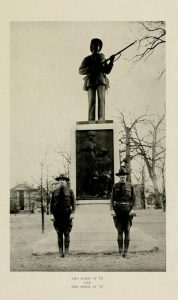Monuments are erected to create messages, and these structures actively work to develop public memory. The Center for the Study of the American South, using the expertise of other units of the University of North Carolina at Chapel Hill (including Wilson Library and the University of North Carolina Press), has curated a list of resources for learning more about monuments, their creation, and the ways their visual rhetoric has been both cultivated and contested.
UNC-Chapel Hill Confederate Monuments

A Guide to Resources About UNC’s Confederate Monument
Explore this guide made by Wilson Library about UNC’s Confederate Monument, Silent Sam. It has primary sources and other documents about the history and reception of the statue from the University Archives and other collections. This includes documents related to planning, fundraising, the dedication of the monument, and even the growing collections involving current discussions and protests of Silent Sam. As new documents are discovered related to Silent Sam, they are added to the Archival Resources section of this guide.
A Guide to Researching Campus Monuments and Buildings
This guide from University Libraries is designed for those interested in the history and controversy of the physical landscape at UNC-Chapel Hill. This includes monuments, buildings, and spaces, including Silent Sam, the two Caldwell monument, and the Unsung Founders Memorial. This guide was created in Summer 2015 and is updated when new research is discovered.
A Letter to Chancellor Folt, August 24, 2018
A letter from 35 members of the UNC History Department to Chancellor Folt about letting Silent Sam remain fallen on the ground. It said: “he should be displayed as a contextualized, historical artifact within an appropriate educational space, not in a position of honor. The monument is undeniably a part of UNC’s past, but he no longer needs to be part of UNC’s future.”
The History Department’s Statement on Silent Sam
“The faculty of the Department of History urges the officers of UNC and other state officials to pursue every avenue to remove the “Silent Sam” monument. For more than a century it has stood in the most conspicuous public space on our campus. Then and now, the location of the monument speaks to the intent of its creators to ensure that the heritage they commemorated would have pride of place at the front door of the state’s flagship university.”
Silent Sam Was a Symbol of Mob Violence: Op-Ed
In the News & Observer, History Professor James Leloudis wrote: “For more than a century, Silent Sam stood as a sentinel of white supremacy that lent dignity and respectability to systematic mob violence. This is the larger issue of law and order that is at stake in recent events. It has haunted our state and nation for generations, and as yet it remains unresolved.”
Confederate Monuments in North Carolina
Guide for Researching NC Monuments
North Carolina has over 200 public monuments and memorials honoring the Civil War. This guide is for those interested in learning about these Confederate monuments and memorials. The sections include general information, organization, and monuments in North Carolina.
Commemorative Landscapes of North Carolina
This is an inventory of NC’s monuments, shrines, and public art, including those related to the Civil War. An aim is for North Carolina citizens to understand the state’s landscape they have inherited and make informed decisions about the future. This is a digital collection with over 1000 historical monuments across North Carolina. The site does not claim to be final, and it does not include state highway markers and historic home sites.
Silent Sam and other Confederate Monuments Rose on Race: Op-Ed
In the News & Observer, a Ph.D. candidate talks about the dedication speeches that were given at Confederate soldier monuments in North Carolina
Confederate Monuments Around the Country
Public Symbols of the Confederacy
The Southern Poverty Law Center’s interactive map shows 114 Confederate symbols have been removed, but there are many that still remain.
Race and Cultural Landscapes: A Conversation with W. Fitzhugh Brundage (2017)
The History Department Head talks about Confederate Monuments with TCLF about whether to put the statues in proper context or remove them.
Books to Read
Savage, Kirk. Standing Soldiers, Kneeling Slaves: Race, War, and Monument in Nineteenth-Century America. Princeton University Press, 1998.

Cox, Karen L. Dixie’s Daughters: the United Daughters of the Confederacy and the Preservation of Confederate Culture. University Press of Florida, 2003.
Blight, David W. Race and Reunion: the Civil War in American Memory. The Belknap Press of Harvard University Press, 2002.
Brown, Thomas J. The Public Art of Civil War Commemoration: A Brief History with Documents. Bedford/St. Martins, 2004.
Foster, Gaines M. Ghosts of the Confederacy: Defeat, the Lost Cause, and the Emergence of the New South. Oxford University Press, 1987.
Janney, Caroline E. Burying the Dead But Not the Past: Ladies’ Memorial Associations and the Lost Cause. Univ Of North Carolina Pr, 2012.
Driggs, Sarah Shields., et al. Richmond’s Monument Avenue. University of North Carolina Press, 2001.
More Resources
“Monuments and Memory” essay compilation
By Southern Cultures
By Melanie L. Buffington and Erin E. Waldner
A Memorial to a Man and a Cause: The Tortuous Tale of the Jefferson Davis Monument
By John M. Coski
Southern Oral History Program Podcast: Episode 16
In this 2017 Southern Oral History Program Press Record podcast episode, activists speak with UNC historian Dr. William Sturkey about Confederate symbols on the UNC-Chapel Hill campus.
Return to ImagningFuture.unc.edu
